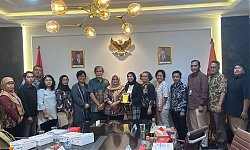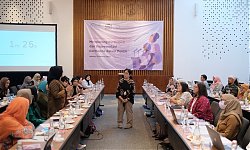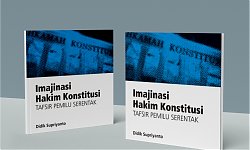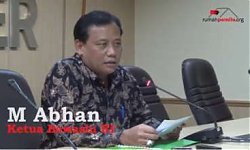The Indonesian Electoral-Industrial Complex has never been stronger. Each election cycle over the last decade has seen an increase in the use of contractors to carry out elements of political campaigning, especially at the presidential and gubernatorial levels.[1]
These contractors offer services ranging from public relations strategy to social media monitoring and, most controversially, to ‘buzzing’. I will analyse this last aspect of the Electoral-Industrial Complex. After unpacking the anatomy of the buzzer industry and providing a moral analysis, I will argue that the agencies that employ buzzers ought to receive more consideration in policy discussions. I will propose a novel solution inspired by developments in Australia and the EU: the development of a self-regulatory Code of Practice in partnership with these agencies. This Code would pursue eradication of disinformation and SARA attacks (Suku, Agama, Ras dan Antargolongan; Ethnicity, Religion, Race and Intergroup), the most pernicious elements of buzzing. This solution has its weaknesses but warrants consideration, as the current suite of policy responses to buzzing have been woefully inadequate.
The first election involving large-scale coordinated campaigning on social media was the 2012 DKI Jakarta gubernatorial election, which saw Joko ‘Jokowi’ Widodo run against Fauzi Bowo, the incumbent.[2] Jokowi’s success in 2012 carried into a 2014 presidential campaign with increased use of buzzers.[3] Pradipa P. Rasidi notes that buzzers first became notorious figures in that election, in which ‘they were popularly called panasbung, an abbreviation for “rice pack troops” (pasukan nasi bungkus) and panastak or “rice box troops” (pasukan nasi kotak).[4] Buzzers’ roles in elections continued to grow with Basuki Tjahaja Purnama, or ‘Ahok’, seeking re-election in 2017. That campaign, coinciding with the 212 Movement, saw an increase in the propagation of SARA by buzzers to attack the Christian and Chinese-Indonesian Ahok.[5] The 2019 presidential election saw a continuation of the trend, with buzzers supporting both tickets.[6] With the presidential election and gubernatorial elections coinciding in 2024, it is likely that the Electoral-Industrial Complex will reach new heights altogether.[7]
Anatomy of the Buzzer Industry
No definition of buzzers has achieved academic consensus. Most conventional definitions describe a buzzer as ‘a person proliferating certain opinions about certain issues or brands, with hopes of wide audience reach’.[8] There is debate, however, on whether buzzers can be volunteers or if they must be financially compensated, and whether non-anonymous accounts should be included in the definition of ‘buzzers’.[9] To avoid an ultimately insignificant definitional debate, this paper will follow the example of Rasidi in taking the broadest approach –including volunteer and non-anonymous users. It also bears mentioning that buzzers first emerged in commercial marketing rather than political campaigning, though this piece is concerned with the latter.
In recent years, numerous academics have sought to analyse the political buzzer industry from various perspectives. From the burgeoning literature, a few general observations can be made. As demonstrated in Figure 1, there is typically a middle layer between the clients and the buzzers themselves. While these can take many forms, this paper will refer to this middle layer collectively as ‘social media marketing agencies’ – who typically offer buzzing as part of a suite of marketing/PR services. It must be noted that there are some middle layers that do not conform to this observation, a key example being Teman Ahok (‘Friends of Ahok’) – a volunteer organisation founded by pro-Ahok activists.[10] Indeed, often political campaigns recruit and manage volunteer buzzers directly. Nonetheless, the Indonesian Electoral-Industrial Complex does appear to be dominated largely by marketing agencies.[11]

Figure 1: Buzzing Industry Structure[12]
Another key observation from this literature relates to the individuals involved in these buzzing operations. Two archetypes have emerged.[13] The first archetype we can call the ‘true believer’ – a legitimate supporter of their buzzing client. Regardless of whether they are getting paid, these buzzers see their work as a meaningful political act to support a candidate they deem morally superior to their opposition. The second archetype we can call the ‘neutral hustler’ – a financially motivated worker who sees their buzzing as merely a supplementary source of income. In either case, the prime demographics appear to be urban young adults, often university educated and politically aware (for the ‘true believer’ at least). In reality, of course, individuals may be somewhere between these two archetypes, or even move from one to the other. In any case, it is important to bear these motivations in mind as we consider the morality of the buzzing industry at large.
Moral Analysis
The first thing to establish is that buzzing cannot be immediately dismissed as morally reprehensible. Political campaigning is clearly a component of a healthy democracy, due to its role in promoting voter engagement and thus accountability. Indeed, political voluntarism is often romanticised as representing strong democratic spirit.[14] Furthermore, other commercial campaigning methods (TV ads, billboards, etc) are widely accepted as an inevitable part of free elections. At worst, these are a mere nuisance. The buzzer industry ought to not be treated radically differently. It is difficult to distinguish between a team of volunteer doorknockers assigned key talking points and a team of social media users spreading the same messages. Furthermore, Rasidi’s paper goes as far as arguing that many buzzers – the ‘true believer’ archetype – find political agency in their role.[15] Such agency should be valued as it counteracts disenfranchisement, cynicism, and fatalism.
There are, however, elements of buzzing that are indisputably immoral. These reprehensible elements of buzzing can be divided into two categories: 1) disinformation, and 2) SARA (Suku, Agama, Ras dan Antargolongan; Ethnicity, Religion, Race and Intergroup) attacks. The objective of disinformation is to blatantly manipulate citizens into voting a particular way, often having a polarising effect in the process. For SARA, the outcome is, again, increased polarisation. Here it is on identity grounds, however, with a very real potential to spiral into violence. To be clear, most content spread by buzzers is conventional political criticism or praise. It is entirely possible for buzzers to operate without spreading disinformation or SARA; even inside the industry such content is seen as an extreme measure. To return to the analogy of the doorknockers, if these volunteers were told to go from house to house spreading disinformation and SARA, clearly an intervention would be necessary. It would not mean that doorknocking in general ought to be banned, but just that steps must be taken to regulate the doorknockers’ behaviour. Buzzers are a similar case: civil society cannot realistically pursue the outright eradication of buzzing (and perhaps should not anyway), but they ought to push for measures to limit the content spread by buzzers.
Policy Analysis
The key regulatory challenge posed by the political campaigning industry is that the political establishment are the primary beneficiaries of the industry. Political leaders are unlikely to be interested in legislating away an electoral advantage. Even if the Government did propose legislation regulating the industry, it would likely only be wielded against opposition campaigns in practice (see, for example, the ITE Law).
It is therefore necessary to look outside conventional regulation for solutions to the problem posed by buzzers. Most policy analysis focuses on disinformation or SARA generally, rather than buzzers specifically, and thus tends to only consider two responses: 1) empowering social media platforms to remove harmful content or disinformation, or 2) increasing public digital literacy.[16] The rise of disinformation has not yet been suppressed, however, and existing regulatory responses have introduced other issues.[17] Clearly, it is necessary to explore novel solutions. This report presents one such idea: self-regulation of the buzzer industry.
Self-regulation of disinformation broadly (i.e., outside of the specific issue of buzzers), is not an entirely new idea. Both Australia[18] and the EU[19] have developed disinformation codes of practice. Social media companies are targeted in both cases (though NGOs are also signatories to the EU’s Code), with the primary objective of encouraging those companies to play a more active role in preventing the proliferation of disinformation. In both cases, however, the Codes are tailored to a different political context to that faced by Indonesia. As discussed above, disinformation in Indonesia is not just spread by disconnected, anonymous individuals, but also by highly coordinated and institutionalised networks of buzzers. To suppress this form of disinformation, an Indonesian Code of Practice would need to target buzzers directly.
The idea is the following. Indonesian civil society collaborate with digital marketing agencies to develop a Digital Campaigning Code of Practice. To sign the Code, agencies would need to meet two core requirements. First, they would need to accept a prohibition on spreading disinformation and SARA. Second, they would need to adopt sufficient transparency measures to verify compliance with the prohibition. Auditors would be empowered to periodically review random samples of the content spread by each agency’s buzzers. These requirements would need to be tightly defined by the implementation stage (e.g. specifying what qualifies as SARA), determined after collaboration with targeted agencies. These two requirements could be perceived as costly, and thus effort must be made to minimise this perceived cost without undermining the efficacy of the Code.
Given altruistic motivations are unlikely, why would agencies join the Code of Practice? A correctly designed Code should attract even the most cynical profit-driven agencies. Being a signatory to the Code would provide positive publicity to the agency. The agency would stand out to politicians searching for a trustworthy and reliable contractor in a murky industry. Another benefit to joining the Code would be in recruiting buzzers themselves. It is likely that individuals would be more willing to work for agencies that require less moral compromise. Furthermore, buzzing agencies have a reputation for being unreliable employers prone to late or incomplete payment of salaries. Signing the Code would imply a degree of credibility that would be reassuring to prospective employees. Finally, buzzers and their agencies do have consciences. Employees within the industry could plausibly put pressure on their organisations to sign the Code.
These justifications are not just empty speculation, but rather supported by the examples of the Australian and EU Codes of Practice. Both succeeded in attracting all major social media companies, presumably for the reasons outlined above. While the companies did not necessarily sign on to all commitments (see Figure 2), they all clearly found sufficient justification for participating in the Codes in some capacity. This sets a very encouraging precedent.

Figure 2: Specific Commitments, Australian Disinformation Code of Practice[20]
Nonetheless, there are reasons to believe that a buzzer-targeted Code of Practice might be less successful than the Australian and EU versions. Politicians are very reluctant to admit to using buzzers (see, for example, Anies Baswedan’s campaign in 2017).[21] Signing the Code of Practice could possibly make agencies less appealing to political candidates who would prefer to partner with an agency with a reduced public profile. This could be mitigated by avoiding framing the code as a ‘Buzzing Code of Practice’ but rather a ‘Digital Campaigning Code of Practice’. The only way to fully prevent this outcome, though, is to develop the Code in collaboration with agencies and, ideally, candidates themselves. That way, the industry can be reassured that the Code provides only reputational gain, not loss.
This collaborative approach is also necessary to ensure that no competitive advantage is lost by joining the Code. Agencies will be reluctant to be the first signatory to the Code, fearing that other agencies will continue using disinformation and SARA and thus gain a competitive advantage. This first-mover fear would not apply to a mere invitation to join a collaborative policy development process, as such a process is not a commitment. Once enough agencies are, metaphorically, in the room, it is likely that they can collectively agree to simultaneously join the code.
Additionally, it would be ideal to have political candidates/campaigns themselves (and semi-linked campaigns like Teman Ahok) sign the Code of Practice. If not, then the Code would be missing a segment of the buzzing industry – buzzers contracted directly to/volunteering directly for a campaign. It is difficult to assess the likelihood of these groups signing on. On the one hand, all the arguments about positive publicity apply. Again, however, political campaigns tend to fear any association with the buzzing industry. An effort would certainly need to be made to invite these groups to the collaborative policy design process.
Finally, even if all the previous concerns are addressed, the Code will never be able to completely prevent buzzers from spreading disinformation and SARA. It is unlikely that all buzzing agencies would sign the Code, and even those that do may occasionally violate it. In the Australian context, for example, early signs indicate that the Code will only be moderately effective.[22] This led to the Australian Government announcing further powers for regulators in January.[23] Any reduction in the spread of disinformation and SARA is a victory, however, so this final weakness is not fatal.
Conclusion
Buzzers are a perplexing policy dilemma, situated at the nexus of many macro trends: the rise of social media, corporate control of politics, polarised religious/cultural tension, and even the emergence of the gig economy. These next 12 months ahead of the 2024 elections could be defining and provide an impetus for rapid and decisive action by Indonesian civil society. As part of this action, a self-regulatory Code of Practice for digital marketing agencies ought to be considered. This Code would not be a panacea, but it has the potential to shrink the role of buzzers in the propagation of disinformation and SARA – an important objective.
Bibliography
Australian Communications and Media Authority, Report to Government on the Adequacy of Digital Platforms’ Disinformation and News Quality Measures (2021) <https://www.acma.gov.au/report-government-adequacy-digital-platforms-disinformation-and-news-quality-measures>
Digital Industry Group Inc, Australian Code of Practice on Disinformation and Misinformation (2022) <https://digi.org.au/disinformation-code/>
European Commission, ‘The 2022 Code of Practice on Disinformation’, European Commission (online, 2022) <https://digital-strategy.ec.europa.eu/en/policies/code-practice-disinformation>
Gallander, Sebastian, ‘Why Volunteering Is the Pulse of Democracy’, TwentyThirty. (2018)
Idris, Ika, Laeeq Khan and Nuurrianti Jalli, ‘Indonesia’s Misinformation Army Ready for War in 2023’, tempo.co (2023)
Lamb, Kate, ‘“I Felt Disgusted”: Inside Indonesia’s Fake Twitter Account Factories’, The Guardian (2018)
Ningtyas, Ika, ‘Menguatnya Kontrol Negara Di Ruang Digital Dengan Dalih Memerangi Hoaks’, Remotivi (online, 2023) <https://www.remotivi.or.id/amatan/800/menguatnya-kontrol-negara-di-ruang-digital-dengan-dalih-memerangi-hoaks>
Ong, Jonathan Corpus and Ross Tapsell, ‘Demystifying Disinformation Shadow Economies: Fake News Work Models in Indonesia and the Philippines’ (2022) 32(3) Asian Journal of Communication 251
Rasidi, Pradipa P, ‘Of Play and Good Men: The Moral Economy of Political Buzzing in Indonesia (Forthcoming)’ [2021] Digital Technologies and Democracy in Southeast Asia
Sastramidjaja, Yatun, ‘Beating the Buzzers’, Inside Indonesia (2021)
Sinpeng, Aim, Ross Tapsell and ISEAS-Yusof Ishak Institute (eds), From Grassroots Activism to Disinformation: Social Media in Southeast Asia (ISEAS-Yusof Ishak Institute, 2021)
Sugiono, Shiddiq, ‘Fenomena Industri Buzzer Di Indonesia: Sebuah Kajian Ekonomi Politik Media’ (2020) 4(1) Communicatus: Jurnal Ilmu komunikasi 47
Camil, Rinaldi and Klara Esti, ‘Di Balik Fenomena Buzzer: Memahami Lanskap Industri Dan Pengaruh Buzzer Di Indonesia’
Digital Industry Group Inc, ‘Disinformation Code’, digi.org.au (2023) <https://digi.org.au/disinformation-code/>
Rowland MP, The Hon Michelle, ‘New ACMA Powers to Combat Harmful Online Misinformation and Disinformation’ (2023) <https://minister.infrastructure.gov.au/rowland/media-release/new-acma-powers-combat-harmful-online-misinformation-and-disinformation>
[1] Aim Sinpeng, Ross Tapsell and ISEAS-Yusof Ishak Institute (eds), From Grassroots Activism to Disinformation: Social Media in Southeast Asia (ISEAS-Yusof Ishak Institute, 2021) (‘From Grassroots Activism to Disinformation’).
[2] Ibid.
[3] Ibid.
[4] Pradipa P Rasidi, ‘Of Play and Good Men: The Moral Economy of Political Buzzing in Indonesia (Forthcoming)’ [2021] Digital Technologies and Democracy in Southeast Asia.
[5] Ibid.
[6] Kate Lamb, ‘“I Felt Disgusted”: Inside Indonesia’s Fake Twitter Account Factories’, The Guardian (2018).
[7] Ika Idris, Laeeq Khan and Nuurrianti Jalli, ‘Indonesia’s Misinformation Army Ready for War in 2023’, tempo.co (2023).
[8] Rasidi (n 4).
[9] Ibid.
[10] Ibid.
[11] Shiddiq Sugiono, ‘Fenomena Industri Buzzer Di Indonesia: Sebuah Kajian Ekonomi Politik Media’ (2020) 4(1) Communicatus: Jurnal Ilmu komunikasi 47 (‘Fenomena Industri Buzzer Di Indonesia’).
[12] Rinaldi Camil and Klara Esti, ‘Di Balik Fenomena Buzzer: Memahami Lanskap Industri Dan Pengaruh Buzzer Di Indonesia’.
[13] See e.g. Jonathan Corpus Ong and Ross Tapsell, ‘Demystifying Disinformation Shadow Economies: Fake News Work Models in Indonesia and the Philippines’ (2022) 32(3) Asian Journal of Communication 251 (‘Demystifying Disinformation Shadow Economies’).
[14] Sebastian Gallander, ‘Why Volunteering Is the Pulse of Democracy’, TwentyThirty. (2018).
[15] Rasidi (n 4).
[16] See e.g. Yatun Sastramidjaja, ‘Beating the Buzzers’, Inside Indonesia (2021).
[17] Ika Ningtyas, ‘Menguatnya Kontrol Negara Di Ruang Digital Dengan Dalih Memerangi Hoaks’, Remotivi (online, 2023) <https://www.remotivi.or.id/amatan/800/menguatnya-kontrol-negara-di-ruang-digital-dengan-dalih-memerangi-hoaks>.
[18] Digital Industry Group Inc, Australian Code of Practice on Disinformation and Misinformation (2022) <https://digi.org.au/disinformation-code/>.
[19] European Commission, ‘The 2022 Code of Practice on Disinformation’, European Commission (online, 2022) <https://digital-strategy.ec.europa.eu/en/policies/code-practice-disinformation>.
[20] Digital Industry Group Inc, ‘Disinformation Code’, digi.org.au (2023) <https://digi.org.au/disinformation-code/>.
[21] Lamb (n 6).
[22] Australian Communications and Media Authority, Report to Government on the Adequacy of Digital Platforms’ Disinformation and News Quality Measures (2021) <https://www.acma.gov.au/report-government-adequacy-digital-platforms-disinformation-and-news-quality-measures>.
[23] The Hon Michelle Rowland MP, ‘New ACMA Powers to Combat Harmful Online Misinformation and Disinformation’ (2023) <https://minister.infrastructure.gov.au/rowland/media-release/new-acma-powers-combat-harmful-online-misinformation-and-disinformation>.











